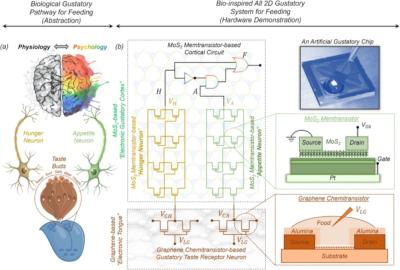Researchers at Penn State University recently developed an electronic “tongue” and an electronic “gustatory cortex” based on graphene ans MoS2. The artificial tastebuds comprise tiny, graphene-based electronic sensors called chemitransistors that can detect gas or chemical molecules. The other part of the circuit uses memtransistors, which is a transistor that remembers past signals, made with molybdenum disulfide. This allowed the researchers to design an “electronic gustatory cortex” that connect a physiology-drive “hunger neuron,” psychology-driven “appetite neuron” and a “feeding circuit.”
For instance, when detecting salt, or sodium chloride, the device senses sodium ions, explained Subir Ghosh, a doctoral student in engineering science and mechanics and co-author of the study. “This means the device can ‘taste’ salt,” Ghosh said.
The properties of the two different 2D materials complement each other in forming the artificial gustatory system. “We used two separate materials because while graphene is an excellent chemical sensor, it is not great for circuitry and logic, which is needed to mimic the brain circuit,” said Andrew Pannone, graduate research assistant in engineering science and mechanics and co-author of the study. “For that reason, we used molybdenum disulfide, which is also a semiconductor. By combining these nanomaterials, we have taken the strengths from each of them to create the circuit that mimics the gustatory system.”
The process is versatile enough to be applied to all five primary taste profiles: sweet, salty, sour, bitter and umami. Such a robotic gustatory system has promising potential applications, Das said, ranging from AI-curated diets based on emotional intelligence for weight loss to personalized meal offerings in restaurants. The research team’s upcoming objective is to broaden the electronic tongue’s taste range.
“We are trying to make arrays of graphene devices to mimic the 10,000 or so taste receptors we have on our tongue that are each slightly different compared to the others, which enables us to distinguish between subtle differences in tastes,” Das said. “The example I think of is people who train their tongue and become a wine taster. Perhaps in the future we can have an AI system that you can train to be an even better wine taster.”
An additional next step is to make an integrated gustatory chip.

It is an interesting shodh &…
It is an interesting shodh & will be of great use in future.